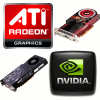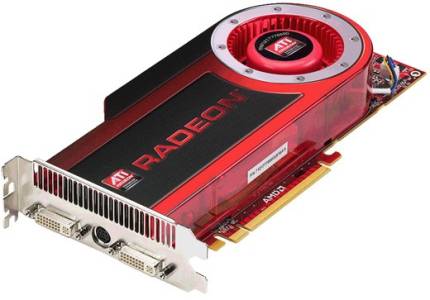- Qualcomm Launches Snapdragon 4 Gen 2 Mobile Platform
- AMD Launches Ryzen PRO 7000 Series Mobile & Desktop Platform
- Intel Launches Sleek Single-Slot Arc Pro A60 Workstation Graphics Card
- NVIDIA Announces Latest Ada Lovelace Additions: GeForce RTX 4060 Ti & RTX 4060
- Maxon Redshift With AMD Radeon GPU Rendering Support Now Available
ATI HD 4870 1GB vs. NVIDIA GTX 260/216 896MB

In the $250 – $300 price-range, there exists two graphics cards that want to see your dollar, but which one deserves it the most? To find out, we’re taking a thorough look at each. In addition to general performance comparison, we’re also taking a look to see which excels where power consumption and temperatures are concerned, in addition to overall pricing.
Page 1 – Introduction
The computer hardware landscape is constantly changing, and if there is one area to look for proof of that, it would be graphics cards. Never before has there been so much value in almost every current model available. Gone seem to be the days where killer performance could be seen only on a $400+ GPU. Today, even some sub $100 cards can handle the latest games at the ultra-high resolution of 2560×1600, which in all respects is rather incredible.
We’ve established over the course of the past few months in our other graphics card reviews that lower-end gamers can see some great value with budget cards, but that sentiment is no less true for the higher-end gamers as well. Although we’ve been in the mindset that “high-end” graphics was equal to separating yourself from $400, today’s $250 – $300 GPUs are in every-single regard, high-end.
In fact, some of today’s affordable GPUs can actually make you step back and wonder what the true value in a multi-GPU setup is. If one GPU can handle most games at incredible resolutions, what’s the need for even more power? Wouldn’t it go to waste? That depends on the resolution, of course, and your desire for robust anti-aliasing. If you aren’t so fussy about AA, multi-GPU setups are probably not for you.
The highest-end cards available right now from both camps are the GeForce GTX 280 and Radeon HD 4870 X2, but both are getting into a much higher price-point, so the appeal is limited. For the upper-end of the mid-range cards, NVIDIA has their GeForce GTX 260 / 216, while ATI has their Radeon HD 4870 1GB. Both cards were released as an attempt to directly counteract the other’s release, ironically enough.
While the “holiday season” means many things to many people, for gamers, it’s without question one of the best times of the year. It doesn’t take a brainiac to figure out why game publishers decide to push out so many games at this time of year, but we won’t argue. This year is no exception. There are so many great games out now, that we have to wonder how we’ll find time to play them all. Five such games are featured in today’s article.
NVIDIA contacted us a couple weeks ago with this story idea, and since we haven’t published a proper “head-to-head” before, the idea struck me as a “must-do”. Their claim: The GTX 260/216 can beat out the HD 4870 1GB in each one of the holiday’s biggest titles.
Sounds like a fair claim to me, but I wasn’t about to conclude on anything until some hard time was spent in front of the PC. All of what I discovered was rather interesting, and it made me even more glad I decided to tackle this article idea. Before we head into our testing results, let’s take a quick look at today’s contestants.
NVIDIA GeForce GTX 260 / 216
When NVIDIA released their GTX 200-series in June, both launch models offered excellent performance. In fact, the performance was so good, that I considered it to be a “major” jump. Their 9-series offered little more than overclocked 8-series cards, but the GTX 200 was the real deal. The GTX 280 in particular offered incredible performance that belittled ATI’s at-the-time current offerings, which is one reason the company decided to charge a staggering $649 at launch for it.

Not long after, ATI released their HD 4800-series, which to our surprise, did a great job of counter-acting NVIDIA’s launch. It was the first time in a long while we saw that happen, and when it did, you could almost hear the sheer number of jaws being dropped in unison. To counteract that launch, NVIDIA followed up with a GTX 260 card that increased the number of cores from 192 to 216. Other specs remained the same, but the jump in cores is still significant enough to show important increases.
ATI Radeon HD 4870 1GB
Months after ATI released their HD 4800-series, they followed-up with a card that should have been available on day one… a 1GB version of the HD 4870. NVIDIA had the right idea for a while that our graphics cards need more memory to battle with today’s high-resolutions. For those who play at under 1920×1200, the need for lots of memory isn’t as important, but it becomes exponentially important as you move further up – especially at 2560×1600.

The same can be said for anti-aliasing, though, so all-around, it’s more important than ever to have a GPU equipped with a good helping of memory. Nowadays, doubling the memory of a graphics card doesn’t increase the price near as much as it used to. You can still sometimes expect a $30 – $40 premium, but if you are running a high resolution and love AA, it’s more than worth it to pick it up.
So are NVIDIA’s claims well-founded? Our goal today is to deliver a definitive answer. Bear in mind that while we are tackling game titles that are hot this holiday season, performance values should carry over to other titles, as well. In addition to general performance, we’ll be taking a look later at power consumption, temperatures and pricing as well, to see which card excels in these different areas.
Before we take a look at all of our results, we highly recommend you read through our testing methodology on the next page. We take our testing very seriously, and as a result, it’s conducted a little different than at most other sites. We’re borderline obsessive, but we feel the extra effort is well worth it. Following that, we’ll begin with both Call of Duty: World at War and Crysis Warhead.
Support our efforts! With ad revenue at an all-time low for written websites, we're relying more than ever on reader support to help us continue putting so much effort into this type of content. You can support us by becoming a Patron, or by using our Amazon shopping affiliate links listed through our articles. Thanks for your support!





